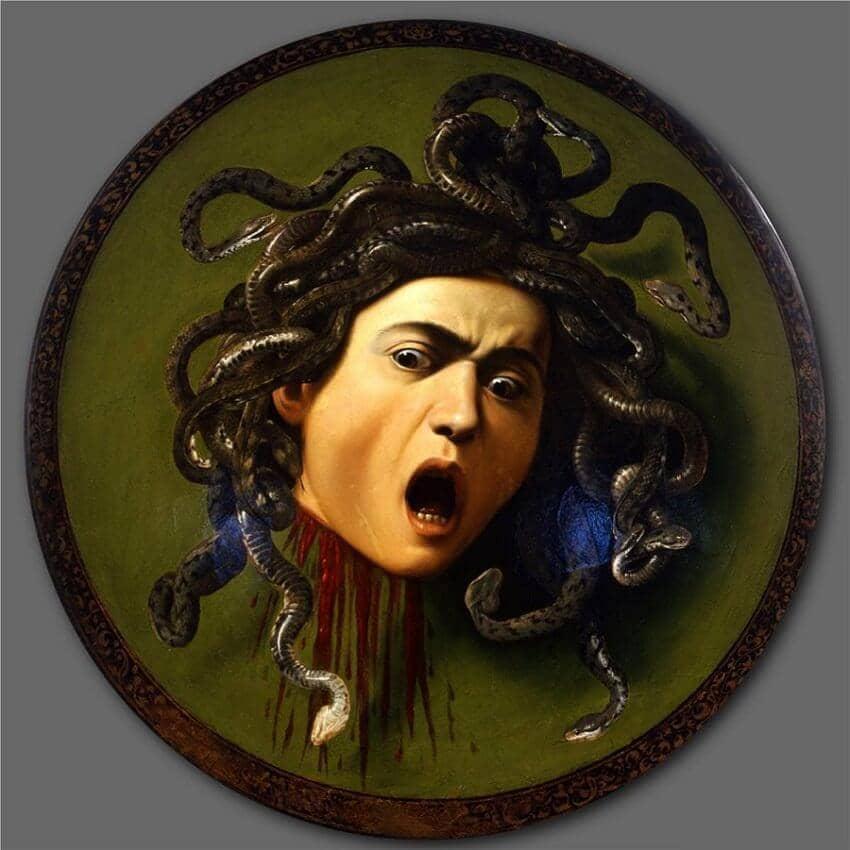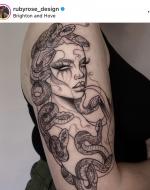Created by Evan Allee on Sun, 03/03/2024 - 12:24
Description:
Introduction
CW: heavy discussions of rape, rape culture, and victim blaming.
A 1993 anthology titled Transforming a Rape Culture spearheaded discourse of the weaponized society against women that we inhabit. Editors define rape culture as, “a complex of beliefs that encourages male sexual aggression and supports violence against women. It is a society where violence is seen as sexy and sexuality as violent…A rape culture condones physical and emotional terrorism against women as the norm” (Buchwald et. al). Christina Rossetti’s Goblin Market is a highly ambiguous work, published at a time where women were adhered to strict societal regulations. Eight years prior to the publishing of Goblin Market, Harriet Hosmer made a bold statement against the treatment of women in a male-dominated society with her sculpture, Medusa. Though there are numerous retellings of mythology, Medusa was often portrayed similarly, as a beast more than a woman. Early depictions of Medusa described her as part-animal, with tusks akin to a boar. Others described her as comically hideous, with a forked tongue or a full beard. Others, a ruthless monster with nothing but harmful intent. Hosmer, however, sympathized with Medusa’s story and represented her as what she is: A woman punished for a sexual trauma inflicted upon her. Now, a symbol for survivors of sexual assault, Medusa raises the voices of solidarity against the reverberations of rape culture and victim blaming. By connecting these stories of mythological creatures and characters, we can explore the evolution of rape culture through Medusa and Rossetti’s goblin men. Rossetti’s use of goblins to exemplify sexual predators coupled with Medusa’s grotesque characterization throughout centuries of tales funneled by men show an eerie dissonance between two similar scenarios: the victim in the woman’s eyes, and the conquest in the man’s. Rossetti paints a visceral picture of abuse in the name of desire and allegories for the aftermath of an assault. While there are many ways you can interpret Goblin Market, I believe the work is a story of autonomy; the loss of it, and the reclamation of it.
Work Cited
edited by Emilie Buchwald, Pamela R. Fletcher, Martha Roth. Transforming a Rape Culture. Minneapolis, MN :Milkweed Editions, 1993.
Images in the Series
Fig. 1. Caravaggio's Head of Medusa (1597)
https://www.caravaggio.org/medusa.jsp
After being commissioned to paint a portrait of Medusa by Cardinal del Monte, a man, Caravaggio fashioned Medusa’s face after his own and painted her on a shield, her expression horrified, her pain suspended. In many tellings of Medusa, after she was raped in Athena’s temple, Athena turned Medusa into a gorgon as punishment. After Medusa was killed by Perseus, her severed head was mounted on Athena’s shield and used as a weapon. Even in death, she was not allowed peace. Like men who claim a false accusation, they channel Caravaggio by shrouding the story of the survivor. They wear the face of the maimed to gather sympathy and silence the survivor. This is similar to Goblin Market, where goblin men can prowl for maids, “Morning and evening / Maids heard the goblins cry: / "Come buy our orchard fruits, / Come buy, come buy:’” (1-4), then desert them after they are satisfied with no repercussions to them, and harrowing effects on the women. The imposed shame rots, and comes the cautionary tale as old as time: How to Not Get Raped. "’We must not look at goblin men, / We must not buy their fruits” (42-43), “‘Their offers / should not charm us, / Their evil gifts would harm us.’” (65-66), “Laura would call the little ones / And tell them of her early prime …Would talk about the haunted glen, / The wicked, quaint fruit-merchant men, / Their fruits like honey to the throat / But poison in the blood” (549-556). Abusers' lives carry on. The abused and criticized are forced to carry.
Fig. 2. Canova's Perseus with the Head of Medusa (1801)
https://www.metmuseum.org/art/collection/search/204758
A facet of the perpetuation of rape culture was men’s inherent need to conquer, and the narrative that they should be allowed to do so as the “superior sex.” Since women’s–in this case, Victorian women’s–earthly possessions became her husband’s, her body became a possession of his as well. Women were not allowed to refuse sex from their husbands. Their husbands were within their legal right to take, and I want to point out that marital rape was not made illegal in the UK until 1991 (NobleSolicitors), and 1993 in the US (VawNet). There is something animalistic and rabid about the act of prying one’s autonomy away from them, whether it is with brute force in Rossetti’s case, or a harpe in Medusa’s. In Canova’s depiction of Medusa, the focus is placed on the heroism of the naked man as he seizes full and final control over a woman’s (“monster,” actually, as stated in the article) body, brandishing her head with pride. This ideal that a man can conquer a woman by force if deemed necessary has spanned through centuries, and is still quite prevalent today. As we see in Goblin Market, Lizzie actually attempts to rescind her consent, and that is when the goblins attack. “‘If you will not sell me any / Of your fruits though much and many, / Give me back my silver penny / I tossed you for a fee.’" (386-389), followed by, “They began to scratch their pates, / No longer wagging, purring, / But visibly demurring … One called her proud, / Cross-grained, uncivil; … They trod and hustled her, / Elbowed and jostled her, / Clawed with their nails, / Barking, mewing, hissing, mocking, / Tore her gown and soiled her stocking, / Twitched her hair out by the roots, / Stamped upon her tender feet, / Held her hands and squeezed their fruits / Against her mouth to make her eat.” (390-407).
https://vawnet.org/material/marital-rape-new-research-and-directions#:~:text=Historically%2C%20most%20rape%20statutes%20read,of%20the%20sexual%20offense%20codes.
https://www.noblesolicitors.co.uk/about/a-guide-to-marital-rape.html#:~:text=The%20case%20of%20R%20vs,citing%20the%20marital%20rape%20exemption.
Fig. 3. Harriet Hosmer's Medusa (1854)
https://www.themarginalian.org/2019/02/27/harriet-hosmer-figuring/
Where the goblin men are described to be animalistic and brutish, Laura and Lizzie are lilies, soft and feminine, same as Medusa in this sculpture. Hosmer sculpted Medusa at the beginning of her transformation rather than after, reminding her audience that Medusa once was also just like Lizzie, Laura, and Jeanie; a woman. Not a beast, not an animal. A woman. The idea that a transformation of the sort happens after a sexual assault, when your body has been taken advantage of and you are left alone to deal with the aftermath of it is a similarity between Medusa’s story and Goblin Market, specifically with the emphasis placed on hair. “She never spied the goblin men / Hawking their fruits along the glen: / But when the noon waxed bright / Her hair grew thin and gray; / She dwindled, as the fair full moon doth turn / To swift decay and burn / Her fire away” (274-280). “Found them no more, but dwindled and grew gray; / Then fell with the first snow” (156-157). Unlike male depictions of Medusa, Hosmer’s Medusa is nearly stoic. This woman is not a monster, she is not dangerous. She is strong in the face of her traumas. Medusa’s transformation and Jeanie and Laura’s rapid aging signify the toll that grief takes on one’s body and mind after an assault, and the person one feels reduced to in its wake.
Fig. 4. Tattoo Artist Ruby Rose's Medusas (2022)
https://www.wellandgood.com/medusa-tattoo-meaning/#:~:text=%E2%80%9CThe%20 Medusa%20tattoo%20can%20 mean,level%2C%20particularly%20by%20men.%E2%80%9D
https://www.tiktok.com/@rubyrose_designs/video/7077661291833232646
In recent years, the Medusa tattoo has popularized throughout social media. A UK based tattoo artist named Ruby Rose responded to a comment requesting her to design some pieces for sexual assault survivors, in which the video received almost 750K likes on TikTok and opened a safe space for survivors to share their stories. While Medusa has been a symbol for survivors in times earlier than 2022, when this video was posted, this was the first time I had seen the meaning virally and specifically as a tattoo. Rose’s designs show Medusa as a woman with a single hand on a snake at all times, whether it is holding or caressing the snake, it shows the woman’s control over what she chooses to share and who to share with. That no matter the aspersions of the public, she is free of self-blame. By reclaiming their bodies with tattoos, women take back control of their own pain, on their own terms, with an artist that they trust. There is a time in one’s healing where their mindset pivots, and they become the conqueror of self, rather than the previously conquered. For Laura and Lizzie, this pivot is the omnipresent love and devotion of sisterhood, and for others, it is permanent ink, and the ability to look at their own body and see art; the physical reminder that they made it out. “Pleasure past and anguish past, / Is it death or is it life? / Life out of death.” (523-525).





